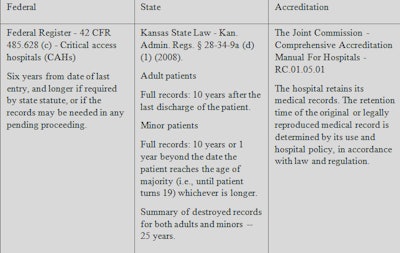
Encounter-based imaging is defined as medical imaging that is intentionally performed during a patient encounter without an associated imaging order. Images are generally acquired at the discretion of the provider. The images generated may be in DICOM or non-DICOM format.
Encounter-based imaging can stem from a wide range of acquisition devices and departments, including point-of-care ultrasound (POCUS) imaging in the emergency department, sports medicine clinic, or other locations; medical photos for dermatology or wound care applications; endoscopy images for gastroenterology; and many other areas across a healthcare enterprise.
Variable strategies
Significant variability exists in encounter-based image management strategies among and within healthcare organizations. Each department has its own individual workflow needs, so specific processes are often developed to meet those requirements. For instance, the primary need of an emergency department may be to develop a workflow that's efficient and provides an ability to perform point-of-care imaging with the fewest possible number of clicks.
 Luke Bideaux, founder of Vega Imaging Informatics.
Luke Bideaux, founder of Vega Imaging Informatics.A workflow driven by departmental leadership may include a process that enables clinicians to capture images on the fly but without any patient context and regard for long-term image storage. However, at the enterprise level, the focus may be on enforcing a standard for image storage procedures, accessibility, and security. Therefore, a workflow driven by enterprise leadership may include a more intensive workflow driven by patient context mapping, which stores images to the vendor-neutral archive (VNA) and makes them accessible through the electronic medical record (EMR).
Due to the lack of governance over encounter-based imaging practices in healthcare today, images are being stored in a variety of ways. In some instances, images are stored temporarily on the given acquisition device and then purged once full storage capacity has been reached. In other cases, encounter-based images are archived on various departmental storage platforms, including PACS, external hard drives, CDs/DVDs, or even shared network folders.
Alternatively, enterprise image management strategies can enable these encounter-based images to be stored on an enterprise PACS or VNA. Encounter-based images can also be printed and scanned into the enterprise EMR.
Encounter-based imaging challenges
Variability in encounter-based image management strategies leads to a variety of challenges. For example, failure to properly archive encounter-based images may result in compliance issues with government regulations, accreditation requirements, and reimbursement guidelines. Limited or nonexistent availability of images also can cause care coordination challenges. In some instances, failure to archive encounter-based images can result in loss of organizational revenue due to the inability to bill for the imaging study.
When images are stored in disparate silos, additional resources are needed to maintain and support all the systems. Image exchange, both internal and external, becomes a greater challenge when these types of images are not managed properly. Nonconventional image storage procedures may also create security risks or lack of protection against disasters. Finally, some encounter-based workflows lack automation, resulting in delays in patient care and end-user overload.
Developing solutions
IT and operational leadership are encouraged to perform an audit of all imaging -- encounter and order-based -- at their institution to determine how their images are being managed across the enterprise. Typically, image management practices within departments such as radiology and cardiology are well-understood, but once the team embarks on auditing of other image-producing departments, they may uncover image management practices that they aren't aware of or don't approve.
Once all current image management practices have been identified and documented, development should begin on strategies that will meet both departmental and organizational needs.
A common trend in today's healthcare field is to develop an enterprise imaging strategy that encompasses both order- and encounter-based workflows. Integrating the Healthcare Enterprise (IHE) International has developed a technical framework, called the Encounter-Based Imaging Workflow (EBIW), that can provide structure to encounter-based imaging components of enterprise imaging strategies.
An evaluation of risks and rewards should be performed as organizations begin to develop their implementation road maps for their strategies. The areas with the lowest risk and highest reward should be prioritized on the road map.
Revenue evaluation
Imaging reimbursement varies greatly based on the place of service, medical specialty, and negotiated payor contracts. Some reimbursements, such as for certain ultrasound imaging procedures, are only possible if images are retained.
For example, the average reimbursement for the professional component of CPT 76604 (ultrasound chest including mediastinum -- real-time with image documentation) is $27.75 based on the 2019 Medicare Fee Schedule for Emergency Medicine. A key requirement for reimbursement of this procedure is the appropriate archiving of images. If the given organization was to perform this procedure 1,200 times annually using proper image archiving and billing procedures, over $33,000 in revenue would be gained.
When considering potential revenue gains from all ultrasound imaging performed in the ED, the value proposition for implementation of a compliant encounter-based image management strategy becomes clear.
Case study
In 2017, a team at Indiana University conducted a small pilot involving the implementation of an encounter-based image management strategy at a community hospital. A strategy for image acquisition, storage, reporting, and technical billing for POCUS in the pulmonary critical care and emergency medicine departments was implemented.
The study included 547 POCUS exams, resulting in $49,053 net revenue for the hospital. Through implementation of the encounter-based image management strategy, POCUS images became accessible through the hospital's EMR -- laying the foundation for wider application of image storage across the enterprise. The results of the study were shared at the 2018 annual meeting of the Society for Imaging Informatics in Medicine (SIIM).
Image retention polices
Organizations should have image retention policies that align with federal, state, and accreditation requirements. Retention requirements vary based on several factors, including patient age, state law, and organizational participation in accreditation, among numerous other variables.
Noncompliance with image retention requirements could lead to liability under state law, loss of accreditation, or even punishment for Medicare fraud. Each organization must determine its own retention requirements by performing a custom regulatory audit. As demonstrated in table 1 below, applicable requirements can be compiled for the development of internal image retention policies.

In summary, imaging performed within a healthcare organization can include order- or encounter-based workflows. Encounter-based imaging workflows vary significantly among organizations and even within a given institution. Numerous challenges exist in meeting both the departmental and organizational needs when developing encounter-based image management strategies.
It's helpful for organizations to understand all image management strategies that are currently implemented across the enterprise. Once existing practices are understood, flexible strategies should be implemented to meet the needs of the enterprise, while still providing tailored solutions to each department's specific needs.
When developing an encounter-based imaging strategy, revenue opportunities and compliance requirements should be evaluated. As always, it's important to equip your leadership team with experts to guide your organization through the complex process of developing these key image management strategies.
Luke Bideaux is the founder of Vega Imaging Informatics, a consulting agency offering managed services and software solutions related to imaging informatics. Luke holds a Bachelor of Science in radiologic technology and certifications in radiography (ARRT) and imaging informatics (ABII). He is an advocate for the advancement of imaging informatics and serves as a member of the IIP Task Force for the Society of Imaging Informatics in Medicine (SIIM).
Luke can be reached at [email protected].
The comments and observations expressed are those of the author and do not necessarily reflect the opinions of AuntMinnie.com.



















